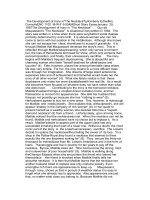the development of irony in the necklace
Bạn đang xem bản rút gọn của tài liệu. Xem và tải ngay bản đầy đủ của tài liệu tại đây (29.59 KB, 2 trang )
The Development of Irony in"The Necklace"byKimberly EdnieMrs.
ConnollyENC 1102 M-W-F 9:00AMShort Story EssayJanuary 29,
1997The Development of Irony in "The Necklace" Guy de
Maupassant's "The Necklace" is situational ironywritten in 1884. The
story was written in a time when there were verydistinct social classes
primarily determined by one's birth. It is abouta woman who can not
come to terms with her position in the middleclass. Although she knows
she can not escape her class, sherefuses to accept it gracefully. It is
through Matilde that Maupassant develops the story's irony. This is
reflected through Matilde'sdaydreaming, which only serves to torment
her, the loss of thenecklace borrowed for show, which only worsens their
economicposition, and finally, their unnecessary sacrifice. The irony
begins with Matilde's frequent daydreaming. She is abeautiful and
charming woman who feels "herself destined for alldelicacies and
luxuries" (4). Fate, however, placed her among themiddle class where
life was very simple. For her, the only means to a more affluent class
was through her imagination. She dreams of"large silent anterooms,
expensive silks and of achievement and famethat would make her the
envy of all other women" (4). What she failsto realize is that these
daydreams only make her more dissatisfiedwith her real life. As a result,
she becomes more focused on whatshe does not have rather than what
she does have. Contributing to the irony is the borrowed necklace.
Matilde'shusband brings a coveted dinner invitation home, and her
firstreaction is concern for appearances. She tells her husband that
theycan not possibly go because she has "nothing to wear" (5).
Herhusband agrees to buy her a new dress. This, however, is notenough
for Matilde; she needs jewelry. She explains that, withoutjewelry, she will
appear "shabby in the company of rich women" (6). In her quest to
present herself as a wealthy woman, she decided toborrow a "superb
diamond necklace" (6) from a friend. Unfortunately, upon arriving home,
Matilde noticed that the necklacewas lost. When the necklace can not be
found, Matilde and herhusband have no choice but to replace it. As a
result, Matilde'sdesire to appear part of the upper class has only
succeeded inmaking them part of a lower one. Without a doubt, the most
ironic part of the story is the Loisel'sunnecessary sacrifice. The Loisel's
decide to replace the necklacewithout telling the owner of its loss. "In a
shop in the Palias-Royal,they found a necklace that seemed to them
exactly like the one theywere looking for" (8). They secure the thirty-six
thousand for thenecklace from Mr. Loisel's inheritance and in the form of
loans. Theystruggle and live in poverty for ten years to pay off the
necklace. Bynow, Matilde looks old. "She had become the strong, hard,
and rudewoman of poor households" (9). Matilde is walking along
theChamps-Elysees when she encounters the friend who loaned her
thenecklace. Her friend is shocked when Matilde finally tells her
aboutthe necklace. It is then that Matilde learns that the necklace her
andher husband toiled to replace was only costume jewelry. Even
amongthe rich there are apprearances to keep up. Maupassant,
through irony, shows us that in pursuit of wealthor status it is easy to
forget what one already has to appreciate. Also,appearances are just
that, no matter what class you belong to. Because Matilde did not
understand this, desire to rise above themiddle class was replaced with a
desire to merely rise above poverty.









